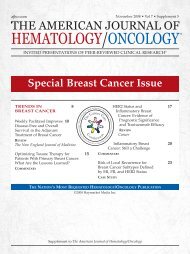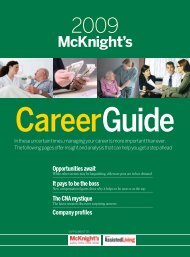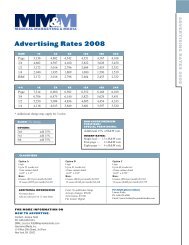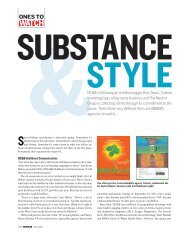Understanding palliative care - Haymarket Media Group
Understanding palliative care - Haymarket Media Group
Understanding palliative care - Haymarket Media Group
You also want an ePaper? Increase the reach of your titles
YUMPU automatically turns print PDFs into web optimized ePapers that Google loves.
Ever<strong>care</strong><br />
Improving <strong>care</strong>, curbing costs<br />
The benefits of <strong>palliative</strong> <strong>care</strong> programs reach into fiscal<br />
realms as well. Research shows that because <strong>palliative</strong><br />
<strong>care</strong> works to prevent and relieve suffering, fewer<br />
people receiving the services require hospital visits and<br />
stays. Palliative <strong>care</strong> also helps ease the transition<br />
between <strong>care</strong> settings, which can further drive patient<br />
satisfaction while steering them to the most appropriate<br />
health<strong>care</strong> resources throughout their illness course.<br />
Even if a patient does require hospitalization, the costs<br />
for those receiving <strong>palliative</strong> <strong>care</strong> consultation are significantly<br />
less than for those who don’t. Live discharge costs<br />
for <strong>palliative</strong> <strong>care</strong> patients who receive intensive <strong>care</strong> are<br />
roughly $183 less per day than those who receive usual<br />
<strong>care</strong>. Care for end-of-life <strong>palliative</strong> <strong>care</strong> patients who<br />
receive intensive <strong>care</strong> and die in a hospital is approximately<br />
$446 less per day than those non-<strong>palliative</strong> <strong>care</strong><br />
patients, according to a 2007 study published in the<br />
Journal of the American Geriatrics Society.<br />
“Complex patients with advanced illness and multiple<br />
comorbidities are among the most expensive cases<br />
in health<strong>care</strong>,” confirmed Mark Leenay, M.D., MS,<br />
chief medical officer, Ever<strong>care</strong> Hospice and Palliative<br />
Care, citing a study published in the February 2007<br />
issue of the American Journal of Cardiology.<br />
“There’s no correlation between the prevalence of<br />
severe chronic illness and total Medi<strong>care</strong> spending,”<br />
continued Dr. Leenay. He did point out, however, the<br />
high correlation between Medi<strong>care</strong> spending and days<br />
spent in the hospital in the last six months, and an even<br />
stronger correlation between Medi<strong>care</strong> spending and<br />
doctor visits in the last six months of life.<br />
According to the 2006 Dartmouth Atlas of Health<br />
Care, if the resource utilization of efficient providers and<br />
systems was implemented nationally, it would reduce<br />
spending for those with severe chronic illness by 30%.<br />
The most physically, emotionally and spiritually fulfilled individuals<br />
are those who are able to stay focused on the things they love<br />
– and those who are chronically or terminally ill are certainly no<br />
exception.<br />
Palliative <strong>care</strong> should embrace each individual’s needs, while<br />
encouraging them, whenever possible, to stay engaged in their<br />
favorite activities or interests. More specifically, <strong>palliative</strong> and<br />
hospice <strong>care</strong> should be shaped by a deep commitment to celebrate<br />
who a patient is as a complete person, emphasizing not just<br />
what they need while they are ill or in their end stages of life, but<br />
what has been meaningful to them throughout their life.<br />
For 89-year-old Virginia Frizzell, it was the company and comfort of<br />
a volunteer and her therapy animals — a horse and a dog — that<br />
helped create an enriching hospice experience (see her photo on<br />
page 2). Despite being very weak from incurable pancreatic cancer,<br />
Frizzell was able to live independently with the support of in-home<br />
<strong>care</strong> and spend quality time with friends and family.<br />
Finding its stride<br />
Although <strong>palliative</strong> <strong>care</strong> is still underutilized, there’s no<br />
question the benefits, both to the patient and families and<br />
to the health<strong>care</strong> system, have led to greater penetration.<br />
A 2007 survey of 4,103 hospitals by the American<br />
Hospital Association revealed more than 30% have a<br />
<strong>palliative</strong> <strong>care</strong> program. The amount jumps to 70% for<br />
hospitals with more than 75 beds. VA hospitals reported<br />
almost 100% <strong>palliative</strong> <strong>care</strong> penetration.<br />
Still, Meier and Connor stressed there’s a well-documented<br />
need for evidence-based <strong>palliative</strong> <strong>care</strong><br />
research to promote more wide-spread support, access<br />
and implementation of the program across the <strong>care</strong><br />
continuum.<br />
The National Consensus Project for Quality<br />
Palliative Care states that further promotion and<br />
support of <strong>palliative</strong> <strong>care</strong> in the U.S. can be driven by<br />
ongoing health professional education in <strong>palliative</strong><br />
<strong>care</strong> principles and practice; increasing access to<br />
<strong>palliative</strong> <strong>care</strong> specialists across the <strong>care</strong> continuum;<br />
and promoting timely access to hospice services to all<br />
eligible patients.<br />
Some of those goals are currently being addressed<br />
by the Joint Commission. Later this year, the agency<br />
will be implementing <strong>palliative</strong> <strong>care</strong> standards as part<br />
of its new Health Care Services Certification Program.<br />
“The proposed standards emphasize the importance<br />
of patient-centered <strong>care</strong> and teamwork in focusing<br />
on the front line of service delivery,” noted Chuck<br />
Mowll, executive vice president, Business Development,<br />
Government and External Relations, The Joint<br />
Commission.<br />
The standards, expected to be launched in August,<br />
cover important aspects related to program management,<br />
providing <strong>care</strong>, managing patient information,<br />
and improving performance.<br />
Meeting the needs of individuals — while focusing on what’s important<br />
4 UNDERSTANDING PALLIATIVE CARE<br />
Pain by<br />
numbers<br />
33-88: Percentage of<br />
nursing home residents<br />
with ongoing pain that<br />
impairs mobility and<br />
robs quality of life 1,2<br />
50: Percentage of<br />
patients who report<br />
moderate or severe<br />
pain at least half the<br />
time in their last three<br />
days of life 3<br />
65: Percentage of <strong>care</strong>givers<br />
of dying patients<br />
who cite inadequate<br />
control of suffering 3<br />
References<br />
1. Miller SC, Mor V, Teno J.<br />
Hospice enrollment and<br />
pain assessment and management<br />
in nursing homes.<br />
J Pain Symptom Manage.<br />
2003;26:791-799.<br />
2. Teno JM, Weitzen S,<br />
Wetle T, Mor V. Persistent<br />
pain in nursing home residents.<br />
JAMA.<br />
2001;285:2081.<br />
3. Leenay M, Opening a<br />
Dialogue: Advance Care<br />
Planning. 2007<br />
“A large part of what we do is spend time one-on-one with<br />
patients, reflecting on their lives to get a better understanding of<br />
what will help them most as they approach this final phase,” noted<br />
Anne Kidd, the hospice social worker who coordinated Virginia’s<br />
home services and regularly monitored her overall condition and<br />
well being.<br />
Knowing Frizzell’s love of horses and riding, Kidd contacted the<br />
volunteer coordinator for their hospice program to determine<br />
whether a horse visit could be arranged. They immediately<br />
reached out to another volunteer who jumped at the chance to<br />
bring her horse, Cody, to Frizzell’s home.<br />
“Because Virginia wasn’t able to travel much, we knew we’d need<br />
to bring the horse to her,” Kidd explained. The joy in Virginia’s face<br />
as she connected with Cody was unmistakable, she added. “It was<br />
so wonderful for her, so rewarding and calming. In fact, Virginia<br />
told us: ‘This is the best day of my life.’”
















